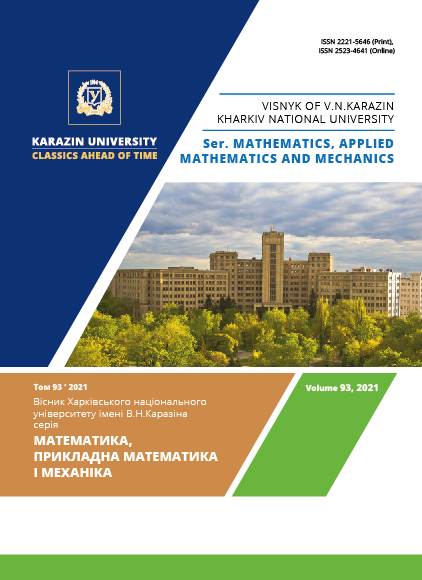Speed of convergence of complementary probabilities on finite group
Abstract
Let function P be a probability on a finite group G, i.e. $P(g)\geq0\ $ $(g\in G),\ \sum\limits_{g}P(g)=1$ (we write $\sum\limits_{g}$ instead of
$\sum\limits_{g\in G})$. Convolution of two functions $P, \; Q$ on group $G$ is \linebreak
$ (P*Q)(h)=\sum\limits_{g}P(g)Q(g^{-1}h)\ \ (h\in G)$. Let
$E(g)=\frac{1}{|G|}\sum\limits_{g}g$ be the uniform (trivial) probability on the group $G$, $P^{(n)}=P*...*P$ ($n$ times) an $n$-fold convolution
of $P$. Under well known mild condition probability $P^{(n)}$ converges to $E(g)$ at $n\rightarrow\infty$. A lot of papers are devoted to
estimation the rate of this convergence for different norms.
Any probability (and, in general, any function with values in the field $R$ of real numbers) on a group can be associated with an element of
the group algebra of this group over the field $R$. It can be done as follows.
Let $RG$ be a group algebra of a finite group $G$ over the field $R$. A probability $P(g)$ on the group $G$ corresponds to the element $ p =
\sum\limits_{g} P(g)g $ of the algebra RG. We denote a function on the group $G$ with a capital letter and the corresponding element of $RG$ with
the same (but small) letter, and call the latter a probability on $RG$. For instance, the uniform probability $E(g)$ corresponds to
the element $e=\frac{1}{|G|}\sum\limits_{g}g\in RG. $
The convolution of two functions $P, Q$ on $G$ corresponds to product $pq$ of corresponding elements $p,q$ in the group algebra $RG$. For a
natural number $n$, the $n$-fold convolution of the probability $P$ on $G$ corresponds to the element $p^n \in RG$. In the article we study
the case when a linear combination of two probabilities in algebra $RG$ equals to the probability $e\in RG$. Such a linear
combination must be convex. More exactly, we correspond to a probability $p \in RG$ another probability $p_1 \in RG$ in the following way.
Two probabilities $p, p_1 \in RG$ are called complementary if their convex linear combination is $e$, i.e. $ \alpha p + (1- \alpha) p_1 = e$
for some number $\alpha$, $0 <\alpha <1$. We find conditions for existence of such $\alpha$ and compare $\parallel p ^ n-e
\parallel$ and $\parallel {p_1} ^ n-e \parallel$ for an arbitrary norm ǁ·ǁ.
Downloads
References
A. D. Bendikov, A. A. Grigor'yan, Ch. Pittet, W. Woess. Isotropic Markov semigroups on ultra-metric spaces, Russian Math. Surveys, 2014. ~ Vol. 69, No 4. ~ P. 589–680. https://doi.org/10.1070/RM2014v069n04ABEH004907
L. Saloff-Coste. Random walks on finite groups. In: H. Kesten (editor). Probability on Discrete Structures, Encyclopaedia of Mathematical Sciences (Probability Theory), - 2004. - Vol. 110}. Springer, Berlin, Heidelberg, - P. 263-340. https://link.springer.com/chapter/10.1007/978-3-662-09444-0_5
A. L. Vyshnevetskiy. Conditions of convergence of a random walk on a finite group, Colloquium Mathematicum. https://doi.org/10.4064/cm8196-5-2020
A. L. Vyshnevetskiy, E. M. Zhmud’. Random walks on finite groups converging after finite number of steps, Journal Algebra and Discrete linebreak Mathematics, 2008. ~ Vol. 7, No 2, ~ P. 123-129. http://dspace.nbuv.gov.ua/handle/123456789/153370
The copyright holder is the author.
Authors who publish with this journal agree to the following terms:
1. Authors retain copyright and grant the journal right of first publication with the work simultaneously licensed under a Creative Commons Attribution License that allows others to share the work with an acknowledgement of the work's authorship and initial publication in this journal. (Attribution-Noncommercial-No Derivative Works licence).
2. Authors are able to enter into separate, additional contractual arrangements for the non-exclusive distribution of the journal's published version of the work (e.g., post it to an institutional repository or publish it in a book), with an acknowledgement of its initial publication in this journal.
3. Authors are permitted and encouraged to post their work online (e.g., in institutional repositories or on their website) prior to and during the submission process, as it can lead to productive exchanges, as well as earlier and greater citation of published work (see The Effect of Open Access).




